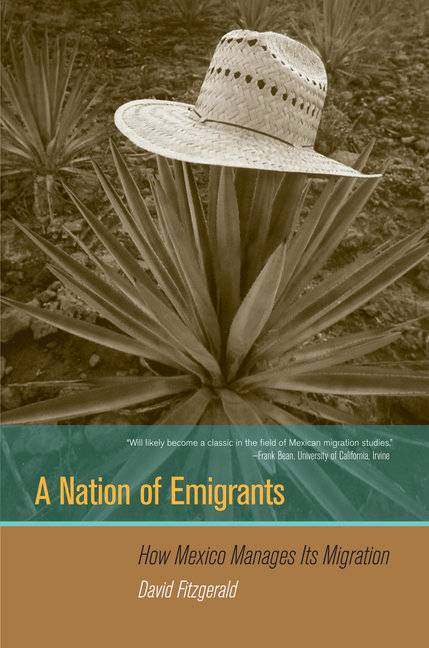
Those tired of tired arguments about immigration will want to pick up David Fitzgerald’s A Nation of Emigrants. Fitzgerald — an assistant professor of sociology at the University of California, San Diego — offers a study about immigration from the perspective of the country the immigrants left behind. This focus allows him to refreshingly avoid disingenuous claims that immigration helps Mexicans by giving them the jobs Americans don’t want, or arguments that race-bait those who dare speak out against illegal movement across the border.
Building on the pioneering work of Paul Taylor, one of the leading scholars of 1920s and 1930s Mexican immigration to America, Nation of Emigrants combines vast statistical research and considerable fieldwork to produce an impressive survey of the history of immigration from the late nineteenth-century, and its impact on sovereignty issues in both the United States and Mexico.
In fact, Fitzgerald’s study proves a corrective to the picture that has emerged from the many one-sided accounts of immigration published to date. Far from undermining sovereignty — as these studies typically argue — Fitzgerald’s research shows that ongoing exchanges between Mexico and the United States demonstrate the strength of it, as each nation clarifies its identity when confronted with “the other.” At the same time, Fitzgerald identifies a new inclination in Mexico to strengthen ties with its expatriate communities abroad. This trend results in a promising new form of citizenship — what he calls “citizenship a la carte.”
An almost comprehensive history, A Nation of Emigrants explores how Mexican officials have struggled in the past and present to address the practical and symbolic effects of massive population outflow. One interesting response is offered by the Catholic Church. Most people presumably are aware that Mexico is predominantly Catholic; perhaps fewer know the history of the Catholic Church’s shifting role in addressing emigration. To drive home the contrast between past and present, Fitzgerald opens his chapter, “The Church’s Eye on Its Flock,” by relating stories circulated since the mid-1990s of Father Toribio Romo, the “coyote saint” who illegally ushered Mexicans across the border. But this myth, like most myths, proves patently false. Toribio, it turns out, was an outspoken detractor of such movement.
And so has the Catholic Church historically been a critic, citing foreign attachments, family disintegration, and religious apathy as the “benefits” of such displacement. But, as the chapter explores, its perspective has since shifted, from one of condemnation to one of resigned acceptance, and the Church now follows its flock into America on a “pluralistic cultural mission,” holding masses in Spanish and recruiting Spanish-speaking priests to help the faithful keep the faith. So effective have its efforts been, in fact, that state now imitates Church in tracking its proverbial masses.
Attending mass is not the only path by which emigrants call forth their homeland. Events such as the Senorita Arandas pageant, a sort of cocktail party that integrates pageant activities — such as the crowning as “queen” a young woman who best represents her local region — helps strengthen ties between those at home and those abroad. The pageant is representative of the nearly three thousand Mexican hometown associations (HTAs) in America. Such organizations redefine community “by including people who are physically absent but who make their presence felt through regular visits and remittances and by sponsoring charity and development projects in their hometown.” These participations prove indispensable in helping migrants reinforce their status as valuable, moral members of their communities of origin.
A Nation of Emigrants importantly challenges what many Americans seem to think is happening as they observe waves of illegal immigrants waft across the border: that Mexico, in fact, promotes the emigration of its citizens. Fitzgerald insists that this is simply not true. Instead, he argues, Mexico has simply acknowledged a trend over which it has little control, and has responded by negotiating a new social contract with what it deems its citizens abroad.
Fitzgerald outlines the details of this contract in the book’s conclusion by concentrating on “ten critical domains of statecraft” (including education, policing, taxation, and controlling the labor supply); so original are some of the solutions that it pays to read the fine print. Through remittances, for example, migrants help alleviate poverty of those who stay behind, so that they “indirectly give to the state while taking little in return.”
Dual nationality, voluntary ties, rights over obligations — these are the ideas floated from the helm to prevent the leaky ship from sinking. Such responses seem appropriate. Still, one is left wondering if Mexican officials now simply view large waves of emigration as inevitable, and are therefore less motivated to increase the standard of living for those left behind; in that respect the resignation seems hardly desirable.
As debates over immigration continue to sprout up, one hopes that Fitzgerald will be invited to the table. His calm prose can help lower the volume when such debates seem poised to devolve into shouting matches. His book, deemed “likely [to] become a classic” by one reviewer, is essential reading for those trying to figure out the best policy to move people across the border, and back again.








